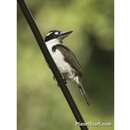Biology
(
englanti
)
tarjonnut Arkive
The sombre kingfisher adopts a hunting strategy that is common to many birds in this family, the 'perch-and-pounce' technique. The kingfisher will perch quietly on a shady branch in the middle level of trees, carefully watching for any movement, and then swoop to the ground to snatch prey, before returning to its perch to consume it. Grasshoppers, centipedes, snakes and lizards have all been recorded in the sombre kingfisher's diet (2) (3). There is nothing known specifically about the sombre kingfisher's breeding behaviour, but all kingfishers nest in holes (4).
Conservation
(
englanti
)
tarjonnut Arkive
The sombre kingfisher is protected by law in Indonesia (3), but at present there are no protected areas within its range. The designation of a protected area on Halmahera has been proposed and this is likely to protect a population of sombre kingfishers (5). Further surveys to determine the distribution, status and ecological requirements of this species are required to provide the basis for its conservation (3).
Description
(
englanti
)
tarjonnut Arkive
The sombre kingfisher's Latin name funebris, means pertaining to burial or funeral, and refers to this bird's dark plumage. The upperparts are blackish to olive-green on the male, and olive-brown on the female, whilst the underparts are white. The head is blackish with a white stripe extending from the bill to the nape, and a lower white stripe that looks like a white collar. The stout bill is blackish, as are the legs and feet. Juveniles are duller and lack the olive wash, and have a white-tipped bill. The voice is a slow and distinctive “ki…ki…ki...” (2).
Habitat
(
englanti
)
tarjonnut Arkive
Occurs in closed-canopy primary forest, tall secondary forest, swamp forest and mangroves, and occasionally enters coconut groves and plantations. It can be found from the coastal lowlands up to 620 meters, but most frequently occurs below 100 meters (3).
Range
(
englanti
)
tarjonnut Arkive
The sombre kingfisher is only known from the island of Halmahera, the largest of the Maluku Islands in Indonesia (3).
Status
(
englanti
)
tarjonnut Arkive
Classified as Vulnerable (VU) on the IUCN Red List 2007 (1).
Threats
(
englanti
)
tarjonnut Arkive
The greatest threat that the sombre kingfisher faces is habitat loss. The destruction and fragmentation of forests on Halmahera has accelerated since the early 1990's, and the commercial exploitation of valuable trees is now widespread. The low-lying forest of Halmahera, which is the preferred habitat for this species, has largely been converted into cultivated areas, and remaining areas are under threat from settlement, conversion to agriculture, selective logging, irrigation schemes, fuelwood collection and mineral extraction (2) (3).

